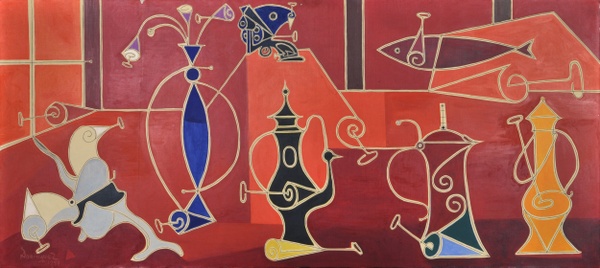Das Werk des Monats - Oscar Dominguez

SARDINE TIN AND SAMOVAR AT DOMINGUEZ
Oscar Dominguez (Oscar Manuel Dominguez Palazon, called)
(San Cristobal de La Laguna, Tenerife, 1906 - Paris, 1957)
"Still life", 1951
Oil on canvas
82 x 181 cm
Signed and dated 1951 lower left.
Donated by the artist to the city of Liège in 1952.
Inv. BA.AMC.05b.1952.21294
The year 2024 marks the centenary of the publication in 1924 of the "Manifesto of Surrealism" by André Breton (1896-1966) and the birth, around Paul Nougé (1895-1967), of Surrealist activity in Belgium. La Boverie's collections contain many works by surrealist and related artists (Magritte, Delvaux, Mariën, Graverol, Stas, etc.), which were loaned for two major exhibitions in Brussels. But the museum also owns other works, including this "Still Life" by the Spanish artist Oscar Dominguez, who was born in Tenerife in 1906. The work was donated by the artist himself to the City of Liège in 1952, following contacts he had made the previous year in Liège with the organisers of the 2nd International Exhibition of Experimental Art: the Royal Society of Fine Arts, the APIAW, and certain members of the Cobra group. Dominguez was hoping to organise a solo exhibition in the Cité ardente, which was eventually held in Brussels in 1955, at the Palais des Beaux-Arts.
Dominguez's 'Still Life' is entirely in keeping with the painter's aspirations - he was one of the most subversive members of the Surrealist movement, which he joined in 1934.
one of the most subversive of the Surrealist movement, which he joined in 1934 - with a method in which he likes to surprise and even provoke the viewer. There is nothing classical about this half-abstract, half-figurative painting, in which a hemmed line lightly outlines the elements of the composition, and flat areas of bright colour present recurring elements in the artist's work. There is the motif of sardine can keys, a commonplace object in everyday Mediterranean life, which already featured in "L'Ouvre-boîte", a surrealist painting by Dominguez in 1936 (1). Several allusions to fishing complete the picture.
On the left, a sensual, languid form suggests a half-open female body, close to a vertical bluish floor lamp, which illuminates a piano. Champagne flutes are combined with the keys of sardine tins, while in the foreground, centre and right, are three distinct vessels: a samovar, a coffee pot and a teapot. The shades of colour distinguish each element individually, but the whole reinvents the ancient theme of the still life in an unconventional way. In Dominguez's case, far from evoking the finiteness of the things in life, the work is, on the contrary, a token of rejoicing. That of a colourful party, combining music, drink, food and the meeting of bodies - perhaps as fortuitous as that of a sewing machine and an umbrella on a dissection table (2).
Dominguez's links with Belgian avant-garde artists began in 1941, when he met the young poet Christian Dotremont, in the entourage of Picasso and the Parisian surrealist group "La Main à plume". Dotremont and Dominguez became friends, and the same year he gave him an illustration for his collection "Noués comme une cravate". In 1945, they both took part in the Surrealism exhibition organised in Brussels by Magritte and Marcel Mariën. Dominguez then joined Noël Arnaud and Dotremont's Surréalisme-Révolutionnaire group, which opposed Breton's Surrealism. Again with Dotremont, he experimented with word-paintings, although he did not join the Cobra movement. A frequent visitor to Brussels, mainly for sentimental reasons, Dominguez exhibited at Robert Delevoy's Apollo gallery in 1950 and again in 1951. On these occasions, Dotremont supported him with a preface and an article (3). At times violent and unstable, going through deep depressive phases, this man who also displayed a devastating sense of humour eventually gave in to his dark moods. A few hours before a visit from Dotremont, Oscar Dominguez took his own life in his Paris studio on 31 December 1957. Today, La Boverie is paying tribute to this major artist who passed through the surrealist movement.
Alain Delaunois
Scientific Attaché / La Boverie - Musée des Beaux-Arts
(1) "La Part du jeu et du rêve. Oscar Dominguez et le surréalisme 1906-1957", catalogue of the exhibition at the Musée Cantini in Marseille, p.103, Paris, Ed. Hazan, 2005.
(2) Alain Delaunois, "Oscar Dominguez", in "Catalogue du Musée des Beaux-Arts de Liège", vol. 1, pp. 276-277, Liège, 2016.
(3) Christian Dotremont, "O. Dominguez, Spanish painter", in "Les Beaux-Arts", no. 485, Brussels, 10 March 1950.


